A Results-Oriented Approach for the Animal Welfare Measure of the European Union’s Rural Development Programme
Abstract
Simple Summary
Abstract
1. Introduction
1.1. Identification of Suitable Indicators
1.2. Determination of Threshold Values and Measure Design
2. Materials and Methods
2.1. Identification of Suitable Indicators
2.1.1. Selection of Indicators by Experts
2.1.2. On-Farm Testing of the Project Indicators
2.1.3. Statistics
2.2. Determination of Threshold Values and Measure Design
3. Results
3.1. Identification of Suitable Indicators
3.1.1. Selection of Indicators by Experts
- Lameness: Percentage of severe lameness (2), due to collinearity with the indicator “prevalence of clinical lameness”;
- Lying behaviour/Cow Comfort Index: Percentage of cows in stalls that are lying down (7), because of difficulties in on-farm data collection;
- Calf mortality: Percentage of euthanized and deceased calves (11), as reliable data proved to be unavailable.
- Percentage of cows with broken tails, an indicator suggested by practitioners, which proved to be relevant;
- Percentage of cows with milk fat-protein-ratio < 1.0 as an indication of rumen fermentation disorders, which also occurred frequently on the surveyed farms and for which data is readily available.
3.1.2. Testing of the Project Indicators
Results of Selected Indicators
Results of Welfare Quality® Assessment
3.2. Determination of Threshold Values and Measure Design
3.2.1. Defining Threshold Values for the Animal Welfare Indicators
- Mastitis: Percentage of cows with SCC > 400,000 mL−1 in milk: The 25% best farms (Q1, green bar) had 0–10.1%, the 25% worst farms (Q4, red bar) had 19–31.4% cows with SCC > 400,000 mL−1. The scientists set their threshold values at 8% (in the green bar), practitioners at 22% (in the red bar).
- Ketosis: Percentage of cows with milk fat-protein-ratio ≥1.5 within 100 days p.p. ranged from 0–8.6% in Q1 and from 17.4–45.0% in Q4. Here the scientists’ thresholds were 14% and the practitioners’ thresholds 18%, both located in the yellow bar.
- Cleanliness: Percentage of dirty cows: The 25% best farms had 0–3.3% dirty cows, the 25% worst farms had 29.7–97.5%. Again, the thresholds were located in the yellow bar and amounted to 16% (scientists) and 17% (practitioners).
- Body condition: Percentage of very lean cows: The 25% best farms had 0%, and the 25% worst farms had 6.7–46.3% very lean cows. This is the only indicator where the two thresholds were located in the red bar (10% scientists; 20% practitioners).
- Lameness: Prevalence of clinical lameness: The 25% best farms had 0–6.1%, the 25% worst farms (red bar) had 20.8–68.8% lame cows. Again, the thresholds were located in the yellow bar (13% scientists, 15% practitioners).
- Integument alterations on limbs: Percentage of cows with severe swellings or lesions on carpus or tarsus: the 25% best farms had 0% cows with integument alterations on limbs, the 25% worst farms (red bar) had 9.8–72.5%. The scientist’s thresholds were set at 10% and those of practitioners at 14% for this indicator and were in the yellow and red bar, respectively.
3.2.2. Remuneration Model
- achieved by the 25% best farms, indicating “good animal welfare”, would receive a payment (per cow and year) in a results-oriented animal welfare measure;
- of the 50% average farms indicating “acceptable animal welfare”, would not receive a payment for this indicator;
- of the 25% worst farms, “unacceptable animal welfare”, would lead to exclusion from the animal welfare measure.
Comparison of Results of Project Indicators and Welfare Quality® Assessment
4. Discussion
4.1. Identification of Suitable Indicators
- “Lameness: Prevalence of severe lameness” because of multicollinearity with “Lameness: Prevalence of clinical lameness”.
- “Lying behaviour/Cow Comfort Index: proportion of cows in stalls that are lying down”. The Cow Comfort Index is an indicator of lying behaviour. It was primarily designed for cubicle housed cows [22] and is not suitable for assessment of other housing systems (e.g., deep litter), which are also common in dairy farming in Germany (mostly in organic farms). Furthermore, our results show large farm-specific differences (range 10.6–100%), which partly resulted from the difficulties of finding a suitable time window.
- “Calf mortality: Percentage of euthanized and deceased calves”, because only inconsistent data was available, resulting in a systematic underestimation of calf mortalities. The cattle register data, which allows for a reliable calculation of mortality of adult cattle, is unsuitable for the calculation of calf mortality as data is not reliably recorded in the first week of the calf’s life. This is due to the fact that entry into the system is only mandatory from the eighth day of life onwards, leading to a situation where some farms record calves that die in the first week while other farms do not.
4.2. Determination of Threshold Values and Measure Design
- cow to cubicle ratio of max. 1:1;
- sufficient number of functional drinkers;
- animal to feeding place ratio of max. 1:1; access to pasture for all cows.
5. Conclusions
Author Contributions
Funding
Institutional Review Board Statement
Informed Consent Statement
Data Availability Statement
Acknowledgments
Conflicts of Interest
Appendix A
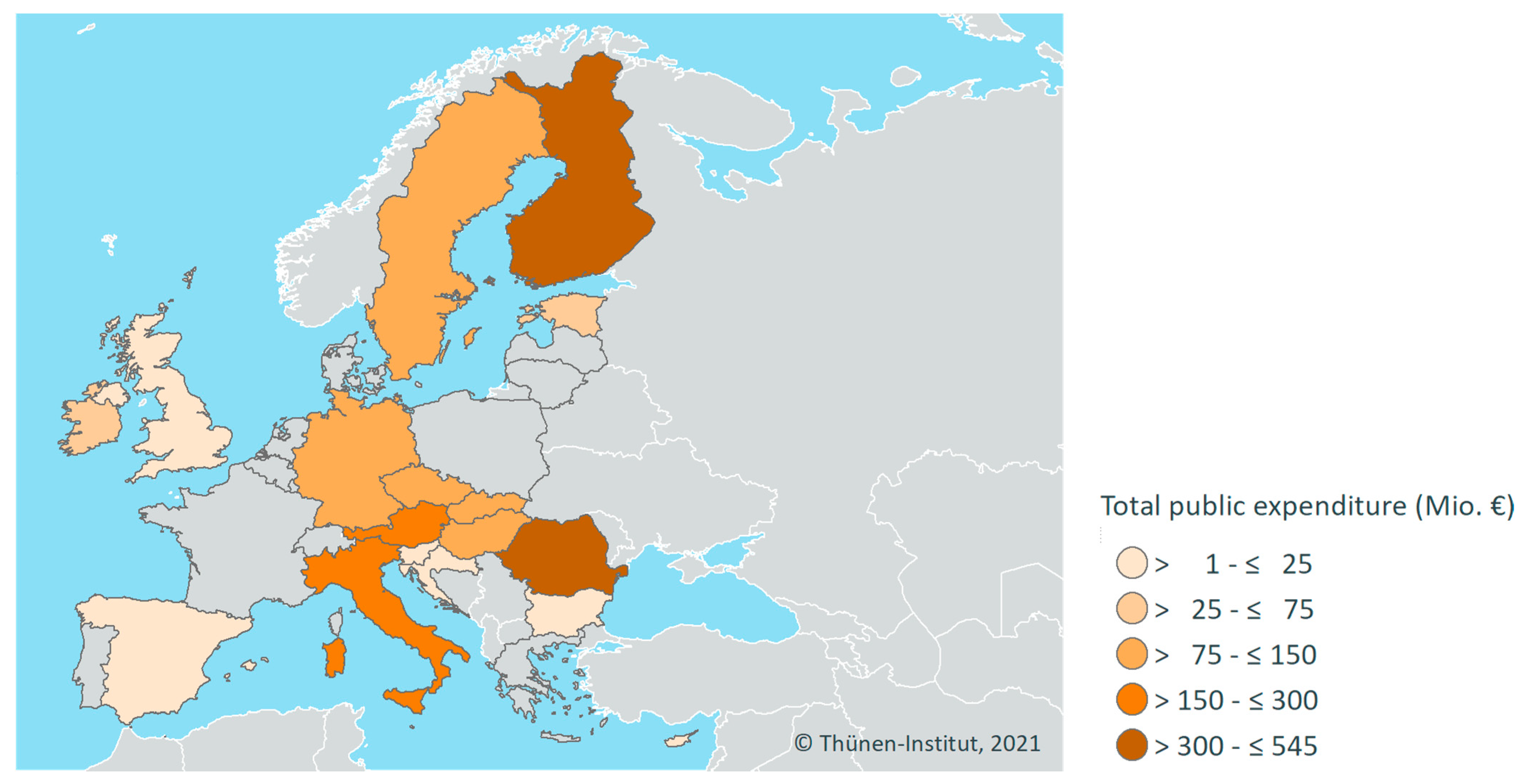
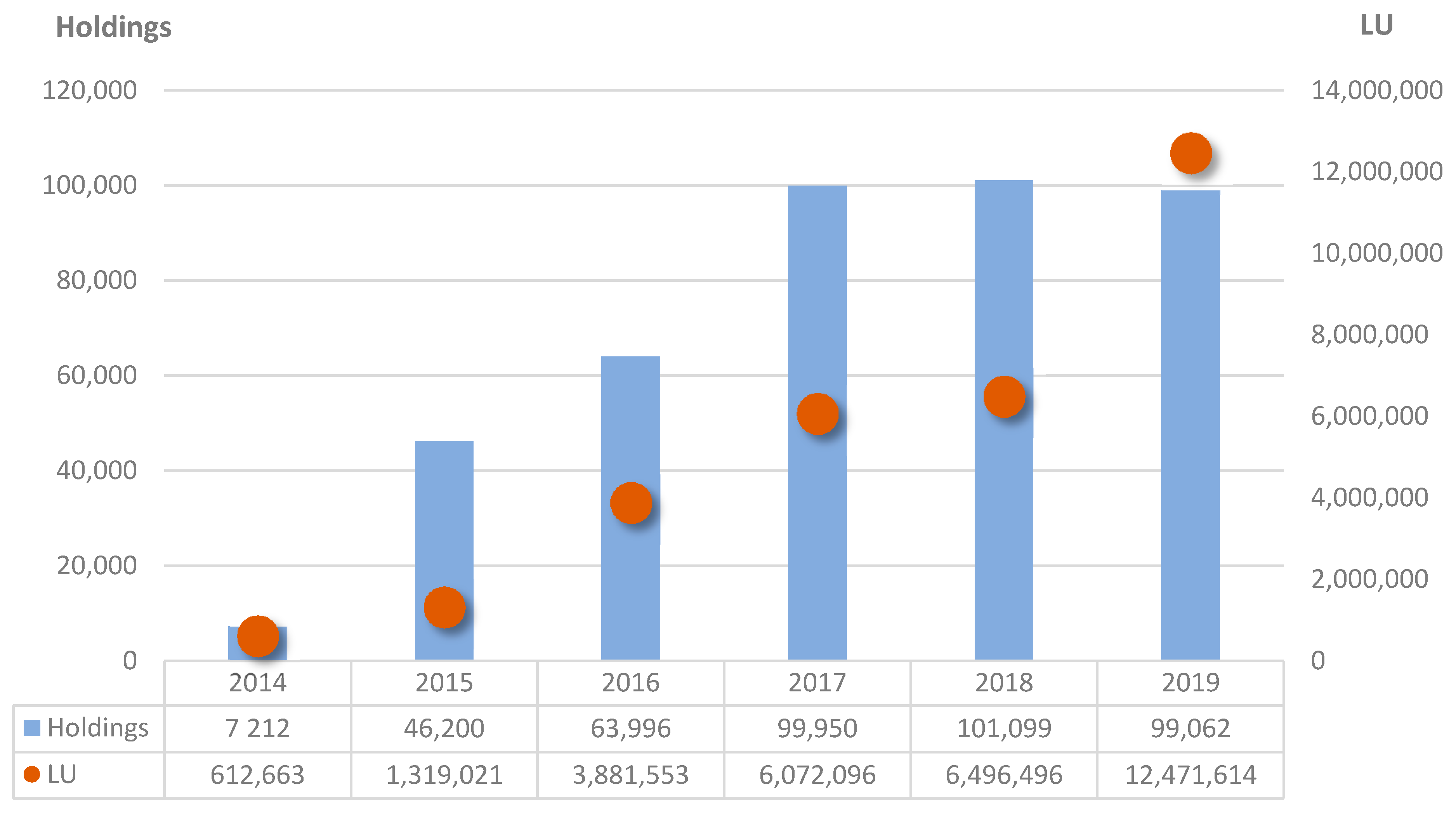
Characteristics of the RDP Animal Welfare Support Measure (M14)
- usable area of 5.5 m2 per animal;
- lying area with a straw-bed on solid floor on which all animals can lie down at the same time;
- animal to feeding space ratio of 1:1 or 1.2:1 in the case of continuous feeding.
Appendix B
| WQ® Principles and Criteria | All Farms (n = 115) |
|---|---|
| Good Feeding | 49.0 (4.2–100) |
| 1. Absence of prolonged hunger | 74.5 (13.1–100) |
| 2. Absence of prolonged thirst | 51.7 (3.0–100) |
| Good Housing | 66.7 (37.0–100) |
| 3. Comfort around resting | 47.2 (0.0–100) |
| 4. Thermal comfort | 100 (100–100) |
| 5. Ease of movement | 100 (100–100) |
| Good Health | 49.3 (30.0–78.8) |
| 6. Absence of injuries | 62.4 (21.3–97.2) |
| 7. Absence of disease | 51.3 (30.2–86.0) |
| 8. Absence of pain induced by management procedures | 63.1 (20.0–100) |
| Appropriate Behaviour | 57.7 (17.0–90.8) |
| 9. Expression of social behaviour | 83.4 (21.5–100) |
| 10. Expression of other behaviour | 51.8 (0.0–100) |
| 11. Good human-animal relationship | 60.8 (27.4–95.4) |
| 12. Positive emotional state | 84.7 (0.7–100) |
| Indicator | Scientists | Practitioners | Farm Survey (n = 115) | |||
|---|---|---|---|---|---|---|
| with Naming of Threshold Values | ||||||
| n = 12–17 | n = 8/9 | Q1 | Q3 | n | ||
| Mastitis: Cows with SCC >400,000/mL in milk 1 | % | 8.4 | 21.8 | 10.1 | 19.0 | 106 |
| Ketosis: Cows with milk fat-protein-ratio ≥1.5 within 100 days p.p.1 | % | 14.1 | 17.6 | 8.6 | 17.4 | 106 |
| Rumen fermentation disorders: Cows with milk fat-protein-ratio <1.0 1 | % | * | * | 4.0 | 10.8 | 106 |
| Cleanliness: Dirty cows 2 | % | 16.0 | 17.4 | 3.3 | 29.7 | 115 |
| Body condition: Very lean cows 2 | % | 10.2 | 19.6 | 0.0 | 6.7 | 115 |
| Lameness: Clinically lame cows 2 | % | 12.6 | 15.3 | 6.1 | 20.8 | 115 |
| Lameness: Severely lame cows 2 | % | 3.8 | * | 0.0 | 2.7 | 115 |
| Integument alterations on limbs: Cows with severe swellings or lesions on carpus or tarsus 2 | % | 9.8 | 13.5 | 0.0 | 9.8 | 115 |
| Integument alterations, other body regions: Cows with severe swellings or lesions on other body regions 2 | % | 9.5 | 13.8 | 2.5 | 12.5 | 115 |
| Cows with broken tails 2 | % | 3.4 | * | 0.0 | 6.3 | 115 |
| Lying behaviour/Cow Comfort Index 3: Cows in stalls that are lying down | % | 74.6 | 76.1 | 75.9 | 87.3 | 115 |
| Cow mortality: Euthanized and deceased cows 4 | % | 3.6 | 5.6 | 1.1 | 3.6 | 105 |
| Calf mortality: Euthanized and deceased calves 5 | % | 6.2 | * | 2.4 | 11.7 | 105 |
References
- European Commission. Special Eurobarometer 442: Attitudes of Europeans towards Animal Welfare; European Commission: Brussels, Belgium, 2016. [Google Scholar]
- European Food Safety Authority. The risks associated with tail biting in pigs and possible means to reduce the need for tail docking considering the different housing and husbandry systems: Scientific Opinion of the Panel on Animal Health and Welfare. EFSA J. 2007. [Google Scholar] [CrossRef]
- European Food Safety Authority. Effects of Farming Systems on Dairy Cow Welfare and Disease; Report of the Panel on Animal Health and Welfare 3686; European Food Safety Authority: Parma, Italy, 2009. [Google Scholar]
- De Jong, I.; Berg, C.; Butterworth, A.; Estevéz, I. Scientific report updating the EFSA opinions on the welfare of broilers and broiler breeders. EFSA Support. Publ. 2012, 9, 295E. Available online: www.efsa.europa.eu/publications (accessed on 11 January 2021). [CrossRef]
- Bennett, R. The Value of Farm Animal Welfare. J. Agric. Econ. 1995, 46, 46–60. [Google Scholar] [CrossRef]
- Lusk, J.L.; Norwood, F.B. Animal Welfare Economics. AEPP 2011, 33, 463–483. [Google Scholar] [CrossRef]
- Harvey, D.; Hubbard, C. Reconsidering the political economy of farm animal welfare: An anatomy of market failure. Food Policy 2013, 38, 105–114. [Google Scholar] [CrossRef]
- European Commission. The Common Agricultural Policy at a Glance. 2020. Available online: https://ec.europa.eu/info/food-farming-fisheries/key-policies/common-agricultural-policy/cap-glance_en (accessed on 11 January 2021).
- The European Parliament and the Council of the European Union. Regulation (EU) No 1305/2013 of the European Parliament and of the Council on Support for Rural Development by the European Agricultural Fund for Rural Development (EAFRD) and Repealing Council Regulation (EC) No 1698/2005. Off. J. Eur. Union 2013, L347, 487–548. [Google Scholar]
- European Commission. ESI Funds Open Data Platform. Available online: https://cohesiondata.ec.europa.eu/ (accessed on 12 December 2019).
- European Commission. List of Potential Agricultural Practices That Eco-Schemes Could Support; European Commission: Brussels, Belgium, 2021. [Google Scholar]
- Bergschmidt, A.; Renziehausen, C.; Brinkmann, J.; March, S. Application of the Welfare Quality® protocols for the evaluation of agricultural policies. In Proceedings of the 6th International Conference on the Assessment of Animal Welfare at the Farm and Group Level: WAFL, Clermont-Ferrand, France, 3–5 September 2014; Mounier, L., Veissier, I., Eds.; Wageningen Academic Publications: Wageningen, Netherlands, 2014; Volume 201. [Google Scholar]
- Burton, R.; Schwarz, G. Result-oriented agri-environmental schemes in Europe and their potential for promoting behavioural change. Land Use Policy 2013, 30, 628–641. [Google Scholar] [CrossRef]
- Farm Animal Welfare Council. Farm Animal Welfare Council Press Statement; Farm Animal Welfare Council: London, UK, 1979. [Google Scholar]
- Fraser, D. Understanding animal welfare. Acta Veterinaria Scandinavica. In Proceedings of the Role of the Veterinarian in Animal Welfare, Animal Welfare: Too Much or Too Little? The 21st Symposium of the Nordic Committee for Veterinary Scientific Cooperation, Værløse, Denmark, 24–25 September 2007. [Google Scholar]
- OIE—World Organisation for Animal Health. Terrestrial Animal Health Code. Introduction to the Recommendations for Animal Welfare. Article 7.1.1. 2019. Available online: https://www.oie.int/en/what-we-do/standards/codes-and-manuals/terrestrial-code-online-access/?id=169&L=1&htmfile=chapitre_aw_introduction.htm (accessed on 30 April 2021).
- Keeling, L. (Ed.) An Overview of the Development of the Welfare Quality® Project Assessment Systems; Cardiff University: Cardiff, UK, 2009. [Google Scholar]
- The Welfare Quality Consortium®. Welfare Quality® Assessment Protocol for Cattle; The Welfare Quality Consortium®: Lelystad, The Netherlands, 2009. [Google Scholar]
- European Food Safety Authority. Panel on Animal Health and Welfare. Panel on Animal Health and Welfare (AHAW) Scientific Opinion on the use of animal-based measures to assess welfare of dairy cows. EFSA J. 2012, 10, 2554. Available online: www.efsa.europa.eu/efsajournal (accessed on 11 January 2021). [CrossRef]
- Buttchereit, N.; Stamer, E.; Junge, W.; Thaller, G. Evaluation of five lactation curve models fitted for fat:protein ratio of milk and daily energy balance. J. Dairy Sci. 2010, 93, 1702–1712. [Google Scholar] [CrossRef] [PubMed]
- Heuer, C.; Van Straalen, W.; Schukken, Y.; Dirkzwager, A.; Noordhuizen, J. Prediction of energy balance in a high yielding dairy herd in early lactation: Model development and precision. Livest. Prod. Sci. 2000, 65, 91–105. [Google Scholar] [CrossRef]
- Cook, N.B.; Bennett, T.B.; Nordlund, K.V. Monitoring indices of cow comfort in free-stall-housed dairy herds. J. Dairy Sci. 2005, 88, 3876–3885. [Google Scholar] [CrossRef]
- Winckler, C.; Willen, S. Reliability and repeatability of a lameness scoring system which may be used as an indicator of welfare in dairy cattle. Acta Agric. Scand. 2001, 51, 103–107. [Google Scholar]
- Windschnurer, I.; Boivin, X.; Waiblinger, S. Reliability of an avoidance distance test for the assessment of animals’ responsiveness to humans and a preliminary investigation of its association with farmers’ attitudes on bull fattening farms. Appl. Anim. Behav. Sci. 2009, 117, 117–127. [Google Scholar] [CrossRef]
- Waiblinger, S.; Boivin, X.; Pedersen, V.; Tosi, M.V.; Janczak, A.M.; Visser, E.K.; Jones, R.B. Assessing the human-animal relationship in farmed species: A critical review. Appl. Anim. Behav. Sci. 2006, 101, 185–242. [Google Scholar] [CrossRef]
- Forkman, B.; Keeling, L. (Eds.) Assessment of Animal Welfare Measures for Dairy Cattle, Beef Bulls and Veal Calves; Welfare Quality Reports No. 11; Cardiff University: Cardiff, UK, 2009; pp. 95–112. ISBN 1-902647-80-7. [Google Scholar]
- Häder, M. Delphi-Befragungen: Ein Arbeitsbuch, 3rd ed.; Springer: Berlin/Heidelberg, Germany, 2013; p. 244. [Google Scholar]
- Whay, H.R.; Main, D.C.J.; Green, L.E.; Webster, A.J.F. Animal-based measures for the assessment of welfare state of dairy cattle, pigs and laying hens: Consensus of expert opinion. Anim. Welf. 2003, 12, 205–217. [Google Scholar]
- Spoolder, H.; Hindle, V.; Chevilllon, P.; Marahrens, M.; Messori, S.; Mounaix, B.; Pedernera, C.; Sossidou, E. A Delphi application to define acceptability levels for welfare measures during long journeys. In Proceedings of the 6th International Conference on the Assessment of Animal Welfare at Farm and Group Level, Clermont-Ferrand, France, 3–5 September 2014; p. 44. [Google Scholar]
- Soisontes, S. Sustainability in Poultry Production: A Comparative Study between Germany and Thailand. Ph.D. Thesis, Universität Vechta, Vechta, Germany, 2015; p. 312. [Google Scholar] [CrossRef]
- Strüve, H.; Toppel, K.; Andersson, R.; Kaufmann, F.; Recke, G. Wandel der nordwestdeutschen Putenhaltungen durch mehr Tierwohl: Ergebnisse einer Expertenbefragung. J. Socio Econ. Agric. 2017, 10, 12. Available online: http://archive.jsagr.org/v9/YSA2017_Strueve.pdf (accessed on 11 January 2021).
- Souza, A.P.O.; Soriano, V.S.; Schnaider, M.A.; Rucinque, D.S.; Molento, C.F.M. Development and refinement of three animal-based broiler chicken welfare indicators. Anim. Welf. 2018, 27, 263–274. [Google Scholar] [CrossRef]
- Krueger, R.A.; Casey, M.A. Focus Groups. A Practical Guide for Applied Research, 4th ed.; Sage: Thousand Oaks, CA, USA, 2009. [Google Scholar]
- Delnoij, D.M.; Rademakers, J.J.; Groenewegen, P.P. The Dutch Consumer Quality Index: An example of stakeholder involvement in indicator development. BMC Health Serv. Res. 2010, 10, 88. [Google Scholar] [CrossRef]
- Winckler, C.; Knierim, U. Welfare Quality® Assessment Protocol—Milchkühe und Mastrinder; KTBL Tiergerechtheit Bewerten; KTBL: Darmstadt, Germany, 2014; pp. 7–17. [Google Scholar]
- Brenninkmeyer, C.; Dippel, S.; March, S.; Brinkmann, J.; Winckler, C.; Knierim, U. Reliability of a subjective gait scoring system for dairy cows. Anim. Welf. 2007, 16, 127–130. [Google Scholar]
- Pannwitz, G. Standardized analysis of German cattle mortality using national register data. Prev. Vet. Med. 2015, 118, 260–270. [Google Scholar] [CrossRef]
- Möhring, W.; Schlütz, D. Die Befragung in der Medien- und Kommunikationswissenschaft: Eine Praxisorientierte Einführung. 2. Überarbeitete Auflage; Springer: Berlin/Heidelberg, Germany, 2010; p. 199. [Google Scholar]
- Hooghe, L.; Bakker, R.; Brigevich, A.; de Vries, C.; Edwards, E.; Marks, G.; Rovny, J.; Steenbergen, M.; Vachudova, M. Reliability and validity of the 2002 and 2006 Chapel Hill expert surveys on party positioning. Eur. J. Political Res. 2010, 49, 687–703. [Google Scholar] [CrossRef]
- Brown, B. Delphi Process: A Methodology Used for the Elicitation of Opinions of Experts; DTIC Document; RAND: Santa Monica, CA, USA, 1968. [Google Scholar]
- AssureWel. Advancing Animal Welfare Assurance. 2021. Available online: http://www.assurewel.org/dairycows.html (accessed on 11 January 2021).
- Zschiesche, M.; Mensching, A.; Sharifi, A.R.; Hummel, J. The Milk Fat-to-Protein Ratio as Indicator for Ruminal pH Parameters in Dairy Cows: A Meta-Analysis. Dairy 2020, 1, 259–268. [Google Scholar] [CrossRef]
- Zapf, R.; Schultheiß, U.; Achilles, W.; Schrader, L.; Knierim, U.; Herrmann, H.J.; Brinkmann, J.; Winckler, C. Indicators for on-farm self-assessment of animal welfare—Example: Dairy cows. Landtechnik. Agric. Eng. 2015, 70, 221–230. [Google Scholar] [CrossRef]
- Zapf, R.; Schultheiß, U.; Achilles, W.; Schrader, L.; Knierim, U.; Herrmann, H.J.; Brinkmann, J.; Winckler, C. Tierschutzindikatoren—Vorschläge für die Betriebliche Eigenkontrolle; KTBL: Darmstadt, Germany, 2015; Volume 507, p. 68. ISBN 978-3-945088-06-7. [Google Scholar]
- Wagner, K.; Brinkmann, J.; March, S.; Hinterstoißer, P.; Warnecke, S.; Schüler, M.; Paulsen, H.M. Impact of daily grazing time on dairy cow welfare—Results of the welfare quality® protocol. Animals 2018, 8, 1. [Google Scholar] [CrossRef] [PubMed]
- Hovi, M.; Sundrum, A.; Thamsborg, S.M. Animal health and welfare in organic livestock production in Europe: Current state and future challenges. Livest. Prod. Sci. 2003, 80, 41–53. [Google Scholar] [CrossRef]
- Lund, V.; Algers, B. Research on animal health and welfare in organic farming—A literature review. Livest. Prod. Sci. 2003, 80, 55–68. [Google Scholar] [CrossRef]
- Sundrum, A. Organic livestock farming, a critical review. Livest. Prod. Sci. 2001, 67, 207–215. [Google Scholar] [CrossRef]
- Van Wagenberg, C.P.A.; de Haas, Y.; Hogeveen, H.; van Krimpen, M.M.; Meuwissen, M.P.M.; van Middelaar, C.E.; Rodenburg, T.B. Animal Board Invited Review: Comparing conventional and organic livestock production systems on different aspects of sustainability. Animal 2017, 11, 1839–1851. [Google Scholar] [CrossRef] [PubMed]
- Kirchner, M.K.; Ferris, C.; Abecia, L.; Yanez-Ruiz, D.R.; Pop, S.; Voicu, I.; Dragomir, C.; Winckler, C. Welfare state of dairy cows in three European low-input and organic systems. Org. Agric. 2014, 4, 309–311. [Google Scholar] [CrossRef]
- Gratzer, E.T. Animal Health and Welfare Planning in Austrian Organic Dairy Farming. Ph.D. Thesis, University of Natural Resources and Life Sciences, Vienna, Austria, 2011. [Google Scholar]
- de Vries, M.; Bokkers, E.A.M.; van Schaik, G.; Botreau, R.; Engel, B.; Dijkstra, T.; de Boer, I.J.M. Evaluating results of the Welfare Quality multi-criteria evaluation model for classification of dairy cattle welfare at the herd level. J. Dairy Sci. 2013, 96, 6264–6273. [Google Scholar] [CrossRef]
- Gieseke, D.; Lambertz, C.; Gauly, M. Relationship between herd size and measures of animal welfare on dairy cattle farms with freestall housing in Germany. J. Dairy Sci. 2018, 101, 7397–7411. [Google Scholar] [CrossRef] [PubMed]
- Heath, C.A.; Browne, W.J.; Mullan, S.; Main, D.C. Navigating the iceberg: Reducing the number of parameters within the Welfare Quality(®) assessment protocol for dairy cows. Animal 2014, 8, 1978–1986. [Google Scholar] [CrossRef] [PubMed]
- Toma, L.; Haskell, M.J.; Barnes, A.P.; Stott, A.W. Relationship between animal welfare, production and environmental performance of dairy farms. In Proceedings of the 7th International Conference on the Assessment of Animal Welfare at Farm and Group Level (WAFL 2017), Ede, The Netherlands, 5–8 September 2017; p. 39. [Google Scholar]
- van Eerdenburg, F.J.C.M.; Di Giacinto, A.M.; Hulsen, J.; Snel, B.; Stegeman, J.A. A New, Practical Animal Welfare Assessment for Dairy Farmers. Animals 2021, 11, 881. [Google Scholar] [CrossRef] [PubMed]
- Schulz, F.; Wagner, K.; Brinkmann, J.; March, S.; Hinterstoißer, P.; Schüler, M.; Warnecke, S.; Paulsen, H.M. Welfare of dairy cattle in summer and winter—A comparison of organic and conventional herds in a farm network in Germany. J. Sustain. Org. Agric. Syst. 2020, 70, 83–96. [Google Scholar] [CrossRef]
- Tierschutzgesetz (TierSchG §11), In der Fassung der Bekanntmachung Vom 18.05.2006 (BGBl. I S. 1206, ber. S. 1313), Zuletzt Geändert Durch Gesetz Vom 20.11.2019 (BGBl. I S. 1626). Available online: https://www.gesetze-im-internet.de/tierschg/__11.html (accessed on 11 January 2021).
- Hachenberg, S.; Au, M.; Behr, B.; Brinkmann, J.; Braunleder, J.; Carrasco, S.; Duda, J.; Doepfer, D.; Gruber, S.; Karatassios, H.; et al. Supporting German dairy farmers: Establishing a monitoring system based on health key indicators extracted from existing control systems. ICAR Tech. Ser. 2019, 24, 325–328. [Google Scholar]
- Schultheiß, U.; Zapf, R.; Schubbert, A.; Rauterberg, S.; Gieseke, D.; Brinkmann, J.; March, S.; Cimer, K.; Knierim, U. Erarbeitung eines Orientierungsrahmens zur Beurteilung des Tierwohls bei der Eigenkontrolle landwirtschaftlicher Betriebe. [Development of reference values for the evaluation of results of on-farm animal welfare self-assessments]. KTBL Schr. 2020, 520, 30–37. [Google Scholar]
- Bergschmidt, A. Eine Explorative Analyse der Zusammenarbeit Zwischen Veterinärämtern und Staatsanwaltschaften bei Verstöβen Gegen das Tierschutzgesetz; Thünen Working Paper 41; Johann Heinrich von Thünen Institute, Federal Research Institute for Rural Areas, Forestry and Fisheries: Braunschweig, Germany, 2015; Available online: https://literatur.thuenen.de/digbib_extern/dn055459.pdf (accessed on 11 January 2021).
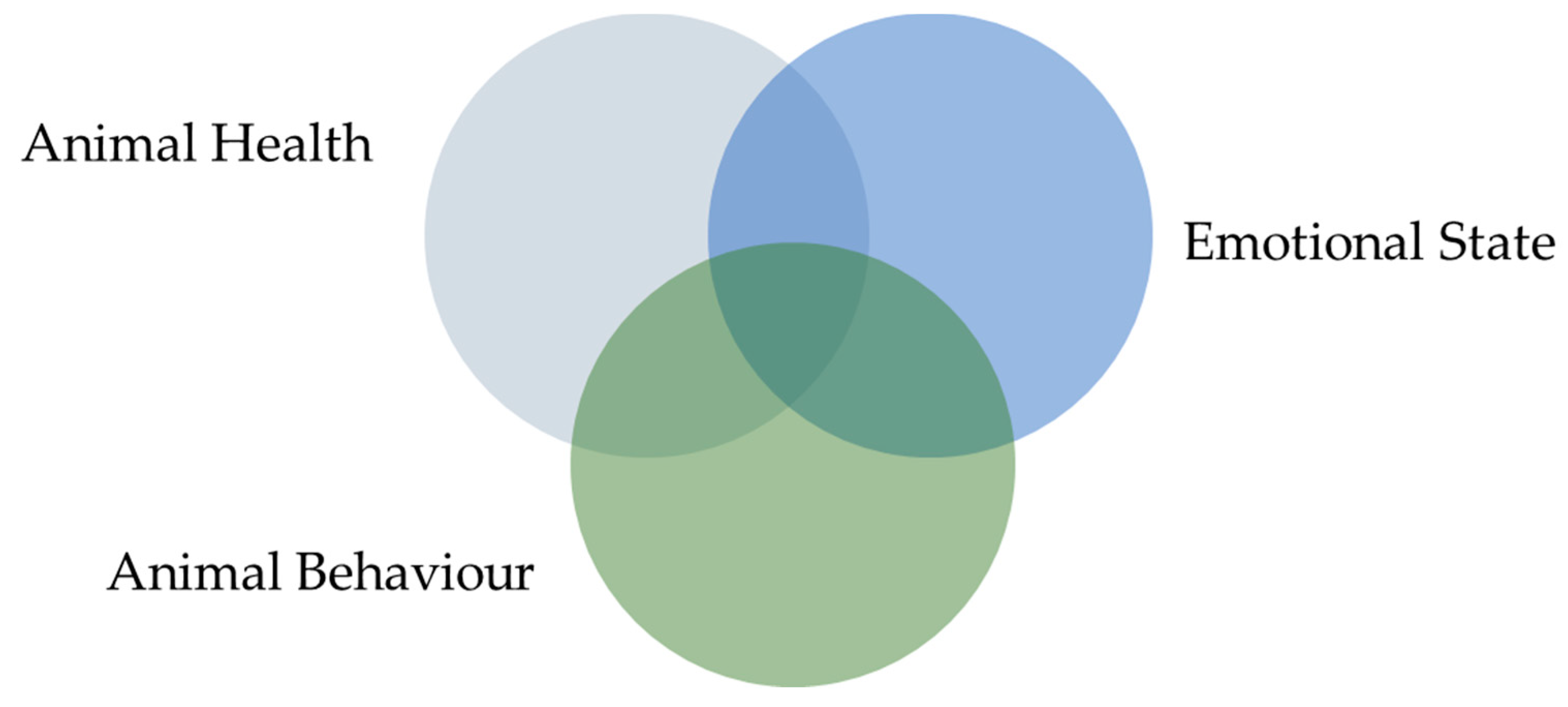
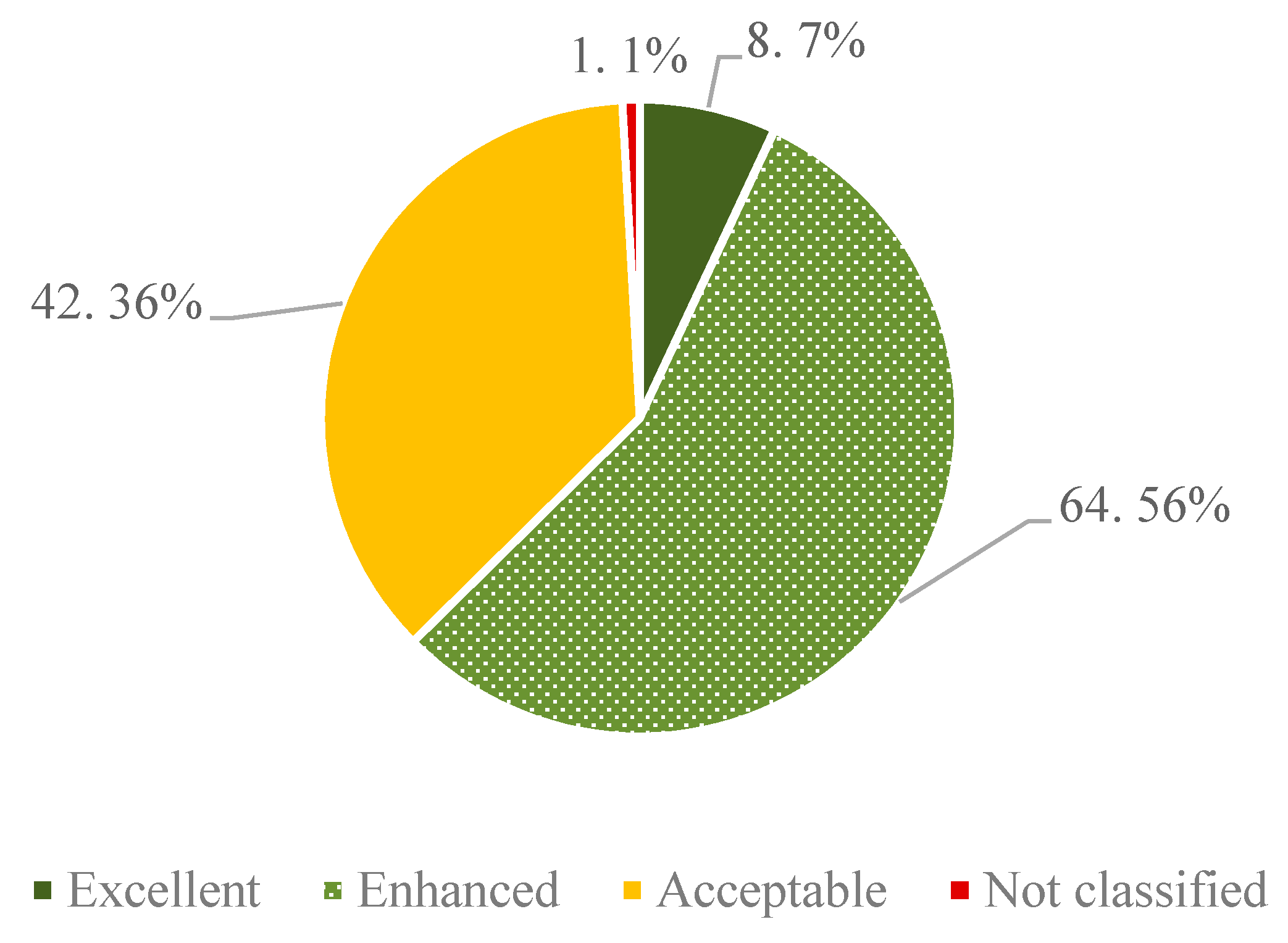
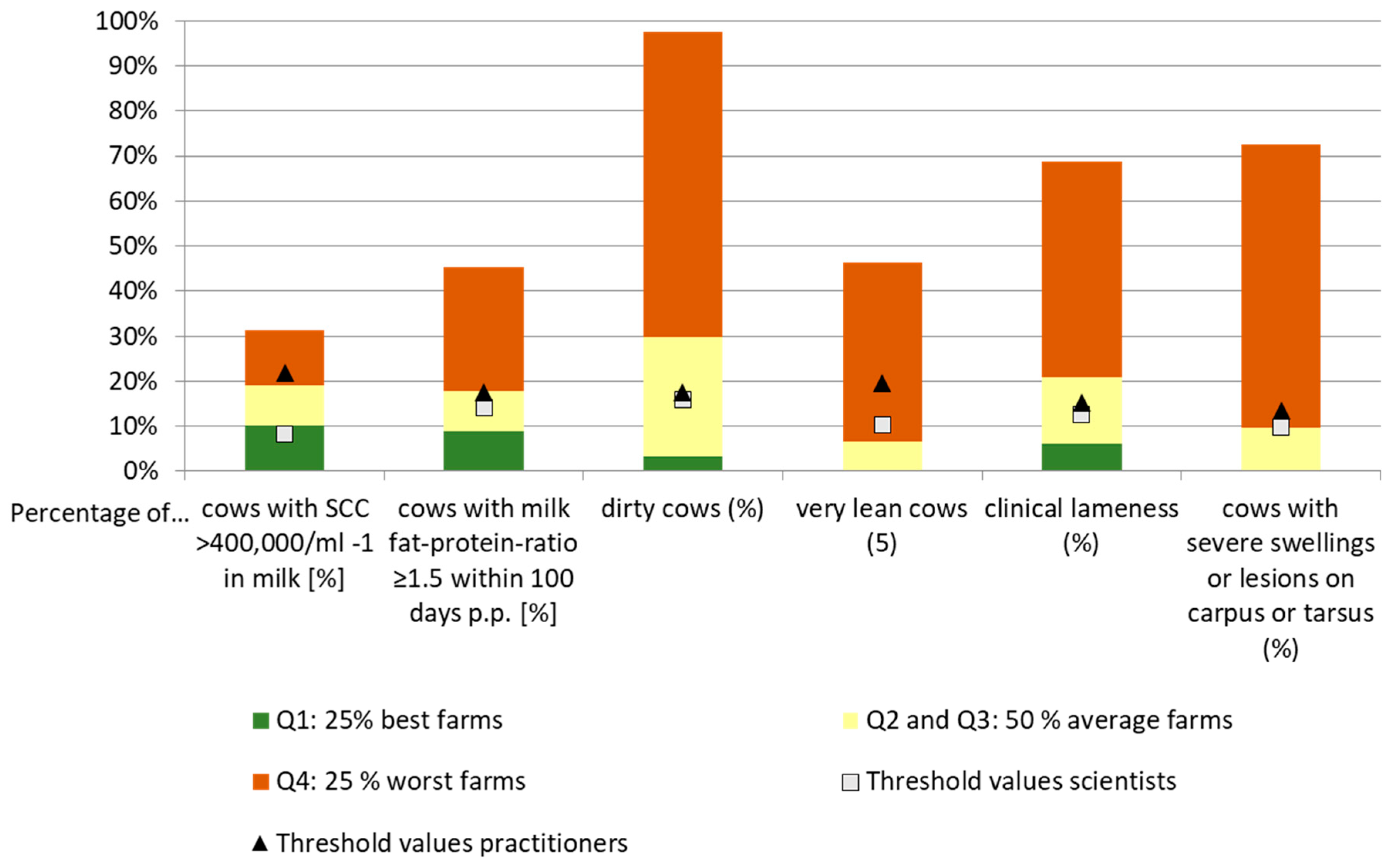
| Item | Unit | Mean (min–max) |
|---|---|---|
| Herd size | dairy cows | 155 (21–1495) |
| Milk yield 1 | kg/cow/year | 8137 (4405–11,988) |
| Herd age 2 | years | 4.9 (3.5–6.9) |
| Culling rate 3 | % | 27.5 (8.7–56.7) |
| Mean productive life time 3 | years | 3.3 (1.9–7.9) |
| Housing system: 75 farms with cubicle housing and 40 farms with free, deeply bedded lying areas | ||
| Scientists (n = 21/17) 1 | Practitioners (n = 20) | Indicator |
|---|---|---|
| ✓ | ✓ | Mastitis: Percentage of cows with SCC > 400,000/mL in milk (%) |
| ✓ | ✓ | Ketosis: Percentage of cows with milk fat-protein-ratio ≥1.5 within 100 days p.p. (%) |
| ✓ | ✓ | Cleanliness: Percentage of dirty cows (%) |
| ✓ | ✓ | Body condition: Percentage of very lean cows (%) |
| ✓ | ✓ | Lameness: Percentage of clinically lame cows (%) |
| ✓ | ✓ | Lameness: Percentage of severely lame cows (%) |
| ✓ | ✓ | Integument alterations on limbs: Percentage of cows with severe swellings or lesions on carpus or tarsus (%) |
| ✓ | ✓ | Integument alterations, other body regions: Percentage of cows with severe swellings or lesions on other body regions (%) |
| ☑ | ✓ | Lying behaviour/Cow Comfort Index: proportion of cows in stalls that are lying down |
| ✓ | ☑ | Cow mortality: Percentage of euthanized and deceased cows (%) |
| ✓ | ☑ | Calf mortality: Percentage of euthanized and deceased calves (%) |
| Indicator | Mean | Min | Q1 | MED | Q3 | Max | n | |
|---|---|---|---|---|---|---|---|---|
| Mastitis: Cows with SCC > 400,000/mL in milk 1 | % | 14.9 | 2.6 | 10.1 | 13.3 | 19.0 | 31.4 | 106 |
| Ketosis: Cows with milk fat-protein-ratio ≥1.5 within 100 days p.p.1 | % | 14.5 | 0.3 | 8.6 | 12.1 | 17.4 | 45 | 106 |
| Rumen fermentation disorders: Cows with milk fat-protein-ratio < 1.0 1 | % | 8.9 | 0.7 | 4.0 | 6.9 | 10.8 | 44.1 | 106 |
| Cleanliness: Dirty cows 2 | % | 20.1 | 0.0 | 3.3 | 12.5 | 29.7 | 97.5 | 115 |
| Body condition: Very lean cows 2 | % | 4.7 | 0.0 | 0.0 | 3.1 | 6.7 | 46.3 | 115 |
| Lameness: Clinically lame cows 2 | % | 14.7 | 0.0 | 6.1 | 12.1 | 20.8 | 68.8 | 115 |
| Lameness: Severely lame cows 2 | % | 1.7 | 0.0 | 0.0 | 0.0 | 2.7 | 12.5 | 115 |
| Integument alterations on limbs: Cows with severe swellings or lesions on carpus or tarsus 2 | % | 7.9 | 0.0 | 0.0 | 3.0 | 9.8 | 72.5 | 115 |
| Integument alterations, other body regions: Cows with severe swellings or lesions on other body regions 2 | % | 10.8 | 0.0 | 2.5 | 8.0 | 12.5 | 56.3 | 115 |
| Cows with broken tails 2 | % | 5.6 | 0.0 | 0.0 | 2.4 | 6.3 | 48.8 | 115 |
| Lying behaviour/Cow Comfort Index 3: Cows in stalls that are lying down | % | 79.5 | 10.6 | 75.9 | 81.9 | 87.3 | 100 | 115 |
| Cow mortality: Euthanized and deceased cows 4 | % | 2.8 | 0.0 | 1.1 | 2.4 | 3.6 | 31.3 | 105 |
| Calf mortality: Euthanized and deceased calves 5 | % | 7.9 | 0.0 | 2.4 | 5.1 | 11.7 | 31.3 | 105 |
| Item | Project Indicator Assessment (Remuneration Model) | ||
|---|---|---|---|
| Welfare Quality® Overall Assessment | Eligible (max 1 Indicator in the Lower Quartile) | Not Eligible (>1 Indicator in the Lower Quartile) | Total |
| Excellent | 6/16% | 2/3% | 8/7% |
| Enhanced | 21/55% | 43/56% | 64/56% |
| Acceptable | 11/29% | 31/40% | 42/37% |
| Not classified | 0/0% | 1/1% | 1/1% |
Publisher’s Note: MDPI stays neutral with regard to jurisdictional claims in published maps and institutional affiliations. |
© 2021 by the authors. Licensee MDPI, Basel, Switzerland. This article is an open access article distributed under the terms and conditions of the Creative Commons Attribution (CC BY) license (https://creativecommons.org/licenses/by/4.0/).
Share and Cite
Bergschmidt, A.; March, S.; Wagner, K.; Brinkmann, J. A Results-Oriented Approach for the Animal Welfare Measure of the European Union’s Rural Development Programme. Animals 2021, 11, 1570. https://doi.org/10.3390/ani11061570
Bergschmidt A, March S, Wagner K, Brinkmann J. A Results-Oriented Approach for the Animal Welfare Measure of the European Union’s Rural Development Programme. Animals. 2021; 11(6):1570. https://doi.org/10.3390/ani11061570
Chicago/Turabian StyleBergschmidt, Angela, Solveig March, Kathrin Wagner, and Jan Brinkmann. 2021. "A Results-Oriented Approach for the Animal Welfare Measure of the European Union’s Rural Development Programme" Animals 11, no. 6: 1570. https://doi.org/10.3390/ani11061570
APA StyleBergschmidt, A., March, S., Wagner, K., & Brinkmann, J. (2021). A Results-Oriented Approach for the Animal Welfare Measure of the European Union’s Rural Development Programme. Animals, 11(6), 1570. https://doi.org/10.3390/ani11061570






